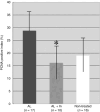Prevention of proliferative changes of forestomach mucosa by blood glucose control with insulin in alloxan-induced diabetic rats
- PMID: 19154414
- PMCID: PMC11158303
- DOI: 10.1111/j.1349-7006.2008.01081.x
Prevention of proliferative changes of forestomach mucosa by blood glucose control with insulin in alloxan-induced diabetic rats
Abstract
Diabetes mellitus is one of the risk factors for carcinogenesis. Recently we reported that alloxan induces squamous cell carcinoma (SCC) with coincidental inflammation, bacteria/fungal infections, and a severe diabetic condition. The present study was conducted to examine the effects of blood glucose control with insulin on the proliferative changes of the forestomach in alloxan-induced diabetic rats. Male 15-week-old WBN/Kob rats were divided into a control group of non-treated rats with naturally occurring diabetes after 40 weeks of age (non-treated group), alloxan-induced diabetic rats (AL group), and alloxan-induced diabetic rats given insulin implant treatment (AL + In group). The animals were sacrificed at 90 weeks of age for histopathologic examination. The blood glucose and urinary glucose level of the AL + In group fluctuated variously from high to normal levels compared with a constantly high level of AL (for 75 weeks) as well as in the non-treated group (for 50 weeks). The mucosal hyperplasia in the forestomach developed in 88.2% of the AL group and 37.5% of the non-treated group, but in only 10.0% of the AL + In group. SCC was only detected in 23.5% of the AL group. Hyperplastic changes were constantly accompanied by inflammation and fungal/bacterial infections in the AL and non-treated groups, whereas inflammation and fungal infection were completely suppressed in the AL + In group. These findings demonstrate that blood glucose control suppressed neoplastic changes in alloxan-induced diabetic rats. We postulate that inflammation together with bacterial/fungal infections under prolonged severe diabetic conditions play a pivotal role in carcinogenesis.
Figures






Similar articles
-
Induction of squamous cell carcinoma of forestomach in diabetic rats by single alloxan treatment.Cancer Sci. 2006 Oct;97(10):1023-30. doi: 10.1111/j.1349-7006.2006.00279.x. Epub 2006 Aug 17. Cancer Sci. 2006. PMID: 16918997 Free PMC article.
-
Effects of the antifungal agent itraconazole on proliferative changes of the forestomach mucosa in alloxan-induced diabetic rats.Toxicol Pathol. 2009 Oct;37(6):790-8. doi: 10.1177/0192623309344204. Epub 2009 Aug 21. Toxicol Pathol. 2009. PMID: 19700660
-
Paradoxical effects of a selective cyclooxygenase-2 inhibitor, etodolac, on proliferative changes of forestomach in alloxan-induced diabetic rats.Exp Toxicol Pathol. 2009 Jul;61(4):371-80. doi: 10.1016/j.etp.2008.10.009. Epub 2008 Dec 9. Exp Toxicol Pathol. 2009. PMID: 19081232
-
Antimicrobial agent, tetracycline, enhanced upper alimentary tract Candida albicans infection and its related mucosal proliferation in alloxan-induced diabetic rats.Toxicol Pathol. 2012 Oct;40(7):1014-9. doi: 10.1177/0192623312447287. Epub 2012 May 18. Toxicol Pathol. 2012. PMID: 22609949
-
The antidiabetic effects of cysteinyl metformin, a newly synthesized agent, in alloxan- and streptozocin-induced diabetic rats.Chem Biol Interact. 2008 May 9;173(1):68-75. doi: 10.1016/j.cbi.2007.11.012. Epub 2007 Dec 4. Chem Biol Interact. 2008. PMID: 18377884
Cited by
-
Enhanced tumorigenesis of forestomach tumors induced by N-Methyl-N'-nitro-N-nitrosoguanidine in rats with hypoinsulinemic diabetes.Cancer Sci. 2010 Jul;101(7):1604-9. doi: 10.1111/j.1349-7006.2010.01589.x. Epub 2010 Apr 7. Cancer Sci. 2010. PMID: 20497417 Free PMC article.
-
miRNA-30e regulates abnormal differentiation of small intestinal epithelial cells in diabetic mice by downregulating Dll4 expression.Cell Prolif. 2016 Feb;49(1):102-14. doi: 10.1111/cpr.12230. Epub 2016 Jan 19. Cell Prolif. 2016. PMID: 26786283 Free PMC article.
-
Endangered Lymphocytes: The Effects of Alloxan and Streptozotocin on Immune Cells in Type 1 Induced Diabetes.Mediators Inflamm. 2021 Oct 19;2021:9940009. doi: 10.1155/2021/9940009. eCollection 2021. Mediators Inflamm. 2021. PMID: 34712101 Free PMC article.
-
Diabetes enhances dental caries and apical periodontitis in caries-susceptible WBN/KobSlc rats.Comp Med. 2011 Feb;61(1):53-9. Comp Med. 2011. PMID: 21819682 Free PMC article.
-
MEK/ERK pathway activation by insulin receptor isoform alteration is associated with the abnormal proliferation and differentiation of intestinal epithelial cells in diabetic mice.Mol Cell Biochem. 2016 Feb;413(1-2):165-78. doi: 10.1007/s11010-015-2650-5. Epub 2016 Jan 2. Mol Cell Biochem. 2016. Retraction in: Mol Cell Biochem. 2024 Mar;479(3):735. doi: 10.1007/s11010-024-04969-3. PMID: 26724951 Retracted.
References
-
- Terai K, Sakamoto K, Goto M et al . Greater development of 1,2‐dimethylhydrazine‐induced colon cancer in a rat model of type 2 diabetes mellitus. J Int Med Res 2006; 34: 385–9. - PubMed
-
- Nunez NP, Oh WJ, Rozenberg J et al . Accelerated tumor formation in a fatless mouse with type 2 diabetes and inflammation. Cancer Res 2006; 66: 5469–76. - PubMed
-
- Ujpal M, Matos O, Bibok G, Somogyi A, Szabo G, Suba Z. Diabetes and oral tumors in Hungary: epidemiological correlations. Diabetes Care 2004; 27: 770–4. - PubMed
-
- Sandhu MS, Dunger DB, Giovannucci EL. Insulin, insulin‐like growth factor‐I (IGF‐I), IGF binding proteins, their biologic interactions, and colorectal cancer. J Natl Cancer Inst 2002; 94: 972–80. - PubMed
-
- Schoen RE, Tangen CM, Kuller LH et al . Increased blood glucose and insulin, body size, and incident colorectal cancer. J Natl Cancer Inst 1999; 91: 1147–54. - PubMed
MeSH terms
Substances
LinkOut - more resources
Full Text Sources
Medical
Research Materials

